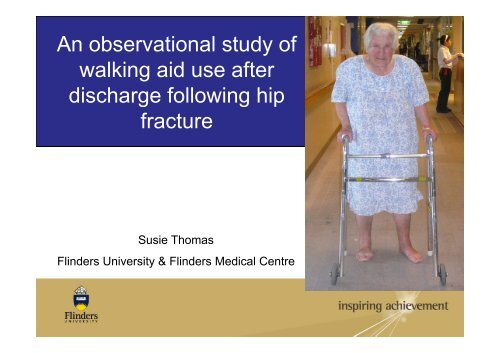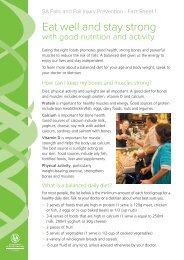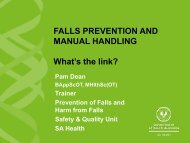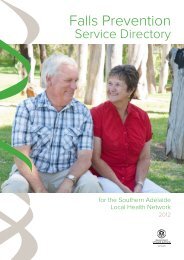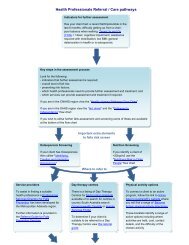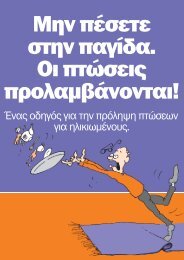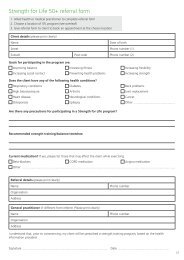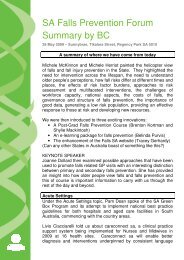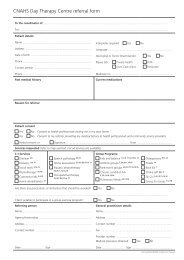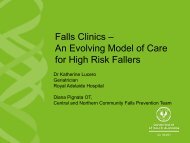An observational study of walking aid use after discharge following ...
An observational study of walking aid use after discharge following ...
An observational study of walking aid use after discharge following ...
Create successful ePaper yourself
Turn your PDF publications into a flip-book with our unique Google optimized e-Paper software.
<strong>An</strong> <strong>observational</strong> <strong>study</strong> <strong>of</strong><br />
<strong>walking</strong> <strong>aid</strong> <strong>use</strong> <strong>after</strong><br />
<strong>discharge</strong> <strong>following</strong> hip<br />
fracture<br />
Susie Thomas<br />
Flinders University & Flinders Medical Centre
Falls and hip fracture<br />
There is an established relationship between<br />
hip fractures and falls in older people:<br />
– up to 90% <strong>of</strong> hip fractures occurring as the<br />
result <strong>of</strong> a fall<br />
– up to 53% <strong>of</strong> people falling again in the six<br />
p p p g g<br />
months <strong>following</strong> their hip fracture
A major public health h issue<br />
Ageing population<br />
+ ↑ Hip Fractures<br />
Population growth 1.7 million (1990)<br />
323 million (2010) 6.3 million (2050)<br />
1.6 billion (2050)
Recovery yfrom hip pfracture<br />
(or not…)<br />
– Up to 36% <strong>of</strong> patients die in first year post<br />
fracture<br />
– 60% <strong>of</strong> patients do not regain pre-fracture level el<br />
<strong>of</strong> mobility<br />
– Only 40% can perform ADL’s independently at<br />
12 months
Physical Function Rehabilitation<br />
PT has an important role:<br />
mobility; function; falls prevention
Research ea<br />
Questions<br />
In the first six months <strong>following</strong> hip fracture:<br />
1. What is the pattern <strong>of</strong> <strong>walking</strong> <strong>aid</strong> <strong>use</strong>?<br />
2. How are <strong>walking</strong> <strong>aid</strong>s obtained and <strong>use</strong>d? Is this <strong>use</strong><br />
appropriate?<br />
3. Are they reviewed by a suitably qualified health<br />
pr<strong>of</strong>essional during this period?
Study Design<br />
Prospective longitudinal <strong>observational</strong> <strong>study</strong> on a<br />
sub-set <strong>of</strong> hip fracture patients t recruited into the<br />
INTERACTIVE trial
INTERACTIVE trial<br />
Individual Nutrition Therapy and Exercise<br />
Regime: AControlled Trial <strong>of</strong> Injured<br />
Vulnerable Elderly<br />
(NHMRC Project Grant 426758)
Eligibility<br />
ibili<br />
Inclusion criteria<br />
Exclusion criteria<br />
Proximal Femur Fracture<br />
>70 years<br />
MMSE score ≥ 18/30<br />
BMI 18.5 kg/m 2 - 35 kg/m 2<br />
Residing g within local service<br />
boundaries<br />
Residing in residential care<br />
Palliative or malignancy<br />
Surgeons orders - unable to<br />
mobilise post surgery<br />
Non English Speaking<br />
Not medically stable within 14 days<br />
<strong>of</strong> surgery
Results<br />
101 participants<br />
enrolled onto<br />
INTERACTIVE trial<br />
(June 2007- Jan 2009)<br />
Withdrew (n=4)<br />
Deceased (n=2)<br />
95 participants<br />
followed for full 6/12
Results<br />
• 92% <strong>discharge</strong>d with a wheeled frame<br />
• 86% were not aware <strong>of</strong> any ygoals<br />
• 94% had no follow up arranged
Results<br />
• 78 (82%) participants changed their <strong>walking</strong> <strong>aid</strong><br />
– On average 8.2 weeks (SD 6.1) post-operatively<br />
• 32% using an inappropriate <strong>aid</strong> or using it incorrectly<br />
• Pre-morbid <strong>walking</strong> <strong>aid</strong> at 6 months post fracture:<br />
– 40% had not returned to their indoor <strong>aid</strong><br />
– 50% had not returned to their outdoor <strong>aid</strong>
Summary<br />
1. Lack <strong>of</strong> <strong>walking</strong> <strong>aid</strong> review by a trained health<br />
pr<strong>of</strong>essional<br />
2. High number <strong>of</strong> participants making inappropriate<br />
decisions about which <strong>walking</strong> <strong>aid</strong> to <strong>use</strong><br />
3. Considerable safety implications in a group already<br />
y p g p y<br />
at high risk <strong>of</strong> falls
Publication:<br />
Thomas S, Halbert J, Mackintosh S, Cameron I D, Kurrle S,<br />
Whitehead C, Miller M, Crotty M. Walking <strong>aid</strong> <strong>use</strong> <strong>after</strong> <strong>discharge</strong><br />
<strong>following</strong> hip fracture is rarely reviewed and <strong>of</strong>ten inappropriate: an<br />
<strong>observational</strong> <strong>study</strong>. Journal <strong>of</strong> Physiotherapy 2010;56(4):267-272.
Acknowledgements:<br />
Ak e<br />
• Co-authors<br />
– Dr Julie Halbert<br />
– Dr Shylie Mackintosh<br />
– Pr<strong>of</strong> Ian Cameron<br />
– Assoc Pr<strong>of</strong> Susan Kurrle<br />
– Assoc Pr<strong>of</strong> Craig Whitehead<br />
– Dr Michelle Miller<br />
– Pr<strong>of</strong> Maria Crotty<br />
• Participants <strong>of</strong> projects<br />
• Funding<br />
– NHMRC Priority Public Health Research Scholarship<br />
– NHMRC Project Grant (INTERACTIVE trial)


